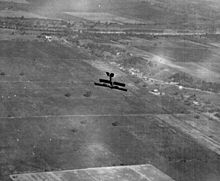- Curtiss Flying School
-
This article is about the flying school in New York. For the Curtiss Flying School in Toronto, see Long Branch Aerodrome.
The Curtiss Flying School was started by Glenn Curtiss to compete against the Wright Flying School of the Wright brothers. The first example was located in San Diego, California.
The Wright brothers took keen interest in the competition, sending the lesser known Lorin Wright to spy and take photographs at the New York facility for a 1914 lawsuit.[1]
Students would work toward completing the Aero Club of America pilot's license. The initial cost was one dollar a minute for the four hundred-minute course. In 1917 the U.S. Army took over operations during WWI. After the war, control went back to Curtiss, who closed Newport operations in 1922.[2]
A large variety of aircraft were used for training, mostly designed and built by Curtiss, and still undergoing flight testing. Among the fleet included the first aircraft to take off from water.[3]
By 1929, the Aeronautical Chamber of Commerce took over licensing of aviation schools. Curtiss schools were registered and required to give two weeks of ground school instruction to new pilots.[4]
Locations
- 1910 San Diego, California. Training in the Curtiss Model D[5]
- 1912 Miami, Florida. Two 200 foot by 800 foot airstrips were provided by the city, with funding to ship in four training aircraft.[6]
- 1913 Hammondsport, New York
- 1915 Toronto, Canada Long Branch Aerodrome, Training in the Curtiss JN-3.[7]
- 1915 Newport News, Virginia Harbor. Site of training for the Canadian Royal Flying Corps. Disbanded in 1922. [8]
Students
- Fred Banbury (1893-1918) in 1916
- Lincoln Beachey (1887–1915) in 1910
- Joseph Bennett (flyer)
- Morris W. Titterington (1891–1928) in 1914[9]
- Harold Frederick Pitcairn (1891-1960) in 1916.
References
- ^ Fred Howard. Wilbur and Orville A Biography of the Wright Brothers.
- ^ John V. Quarstein. World War I on the Virginia Peninsula.
- ^ Edith Dodd Culver. Talespins a story of early aviation days.
- ^ Popular Science. July 1929.
- ^ Meghan Cunningham. Logbook of the Signal Corps No. 1 The United States Army's First Airplane.
- ^ Kevin M. McCarthy. Aviation in Florida.
- ^ Peter Pigott. Flying Canucks II Pioneers of Canadian Aviation.
- ^ Patrick Evans-Hylton. Aviation in Hampton Roads.
- ^ "Titterington dies as plane crashes. Inventor of instruments to make flying safe hits mountain.". New York Times. July 12, 1928. http://select.nytimes.com/gst/abstract.html?res=F60C11F6395C177A93C0A8178CD85F4C8285F9. Retrieved 2007-09-25. "Woman with him killed. She was named beneficiary of insurance policies found on maker of inductor compass. Inventor thrown from plane. Titterington dies as plane crashes. Woman was learning to fly. Hesitated to start flight. Worked to make flying safe. Snyder, Pennsylvania, July 11, 1928. Morris M. Titterington of Brooklyn, one of the best known makers of aeronautical instruments in the country and an inventor of various aviation apparatus, was killed this afternoon ..."
Categories:- Aviation history of the United States
- Aviation schools
- Curtiss-Wright Company
- Companies based in New York
- Aviation stubs
Wikimedia Foundation. 2010.

